Tracing the development of the Internet from dial-up on desktops to 5G mobile networks and the empowerment of artificial intelligence, the tech field is undergoing tremendous transformation. The future digital world will place even higher demands on experience across dimensions such as immersion, engagement, and personalization. Meanwhile, the need for efficient, simple, and user-friendly interfaces among B2B enterprises is growing daily. In today's 2025 landscape, B2B designers must continue to learn, adapt to new technologies and trends, tightly align their design around clients' business values, and emphasize practicality, inclusiveness, and customizability in order to shape superior products and services for business clients. Therefore, drawing from our nearly 10 years of B2B product design experience at DingTalk, we predict that future B2B design trends will exhibit features of diversification, intelligence, and humanization. With in-depth research on product personalization, styling, texture, interface layout, icons, dynamic interactions, and other dimensions of design, we aim to explore the nature and evolution of B2B design together—to offer some useful insights for mastering B2B product design. Today, we will focus on individual personalization of B2B products that helps individuals build their personal images, deliver emotional value, and boost confidence.

Looking back at the evolution of the Internet, from dial-up connections on desktops to 5G mobile access and then AI enhancement, the tech field is undergoing sweeping transformation. Future digital environments will set increasingly higher demands on experiences through dimensions like immersion, engagement, and personalization. At the same time, B2B enterprises have growing demands for efficient, user-friendly, and straightforward interfaces. In 2025, B2B designers must persistently keep learning and adapting to new technologies and trends. By tightly aligning their design practice with clients' business value, emphasizing practicality, inclusivity, and customizability, only then can they create outstanding products and services for enterprise clients.
Therefore, based on the nearly decade of B2B product design experience with DingTalk, we foresee future B2B design trends displaying characteristics of diversification, intelligence, and humanization. We have conducted in-depth research on B2B product design across multiple dimensions such as personalization, style and texture, interface layout, icons, and dynamic interactions, in order to jointly explore the essence and development of B2B design, and also to offer useful insights along the path of mastering B2B product design.
What we intend to share with you today is how B2B personalization empowers individuals to craft unique identities, provide emotional value, and enhance self-confidence.
Three Eras of B2B Design
Initial Stage: Classic and Traditional Styles Centered Around Functionality
First, let's go back to the year 2012—a relatively early age in the evolution of the Internet. At that time, user interface design wasn't as diversified as it is today. Back then, B2B systems, or enterprise applications, were typically presented as client-side applications. This meant that users had to download and install dedicated software, unlike the web applications accessible directly through browsers today. Such setups were limited in terms of flexibility and convenience, leading to cumbersome experiences.
In 2012, modern design systems like Ant Design, Element, and Semi Design had not yet emerged. By comparison, the overall style of B2B design appeared quite outdated. Many systems' interface designs were greatly influenced by popular tools and software of the time, such as Microsoft Office, SAP, and Salesforce. While these products possessed certain functionalities, their interfaces often appeared heavy and lacked visual appeal.
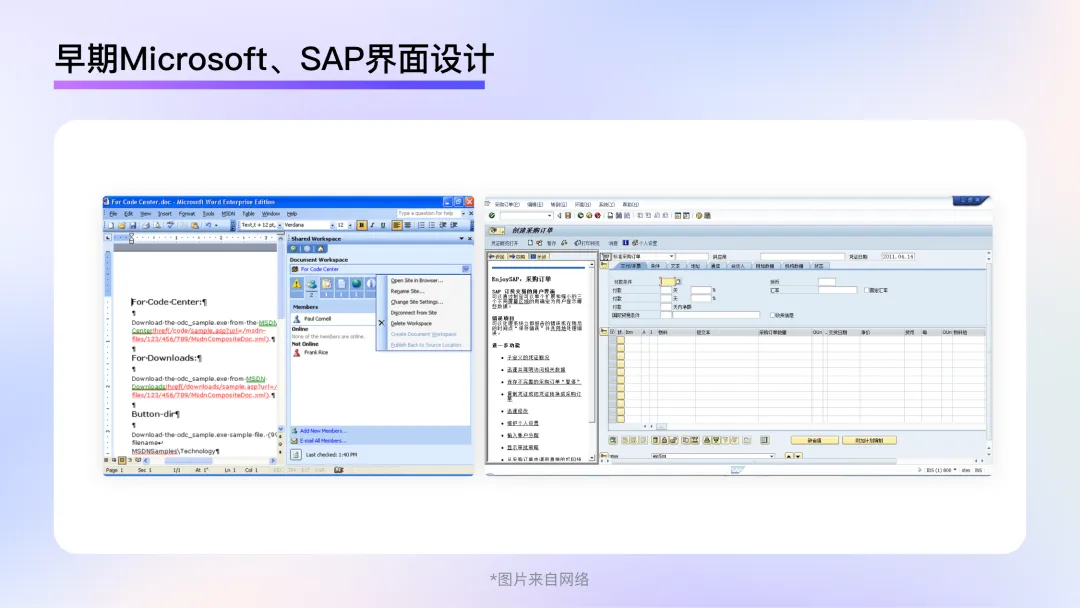
Primary factors contributing to design styles of the early period:
1. Limitations in Technical Frameworks: At the time of early software development, mature front-end frameworks and libraries were lacking. Developers had very limited technological choices compared to the abundance of today's tools and frameworks (such as React, Vue.js, Angular, etc.). Under these circumstances, developers often focused on functional realization while neglecting elegance of interface and user experience. As a result, many products prioritized fulfilling basic functional requirements rather than striving for refined, visually appealing interfaces, leading to many products having monotonous and outdated appearances.
2. Emphasis on Practicality: Many products at the time, including popular Office software, were built with practical consideration rather than being the optimal solution for aesthetic appeal or enhanced user experience. This lack of awareness of design aesthetics often resulted in rough, coarse design work, deviating from the precision and delicacy seen in modern design practice.
Growth Stage: Design Systems Delivering Simple and User-Friendly Interactions
With rapid advancement in information technology, enterprises increasingly prioritize efficient management and user experiences. The emergence of Fiori and Salesforce not only marked product innovation but also sparked a renewed industry-wide recognition of the importance of design in the B2B context. In the past, many businesses focused solely on functional realization, ignoring the user experience provided by design. Fiori and Salesforce successfully drew users' attention through elegant interfaces and superior interaction experiences, gradually leading businesses to realize that design can also enhance product value.
In China, the subsequent release of design systems such as Ant Design and Element marked the standardization and normalization of design in B2B products. These design systems offered comprehensive design languages and component libraries, enabling businesses to design products more efficiently and consistently.
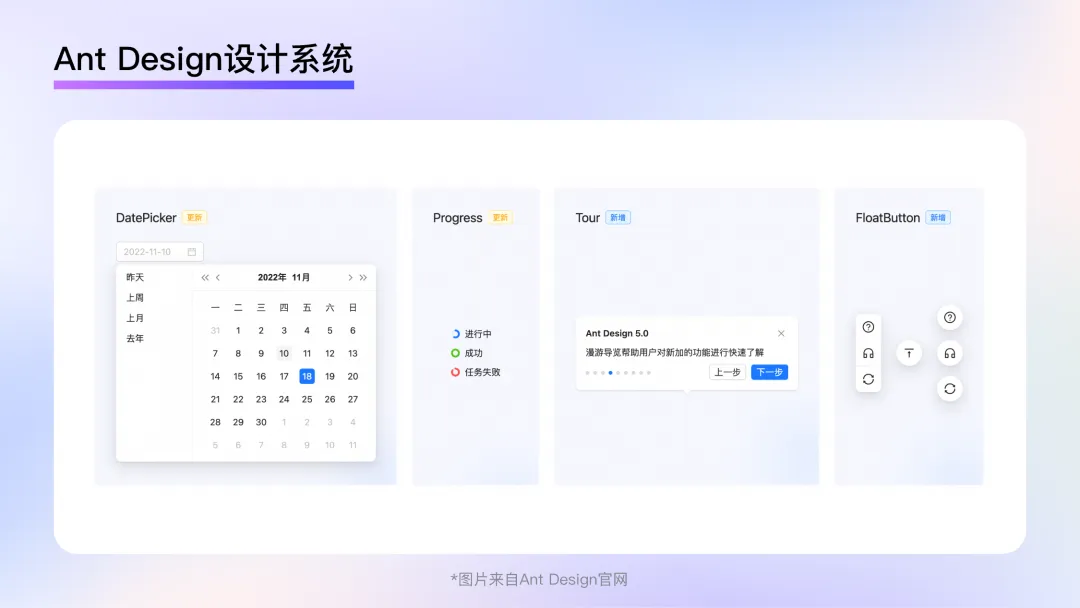
Motivating Drivers of the Intermediate Stage Trends:
1. Growing Internal Demand: As businesses expanded and diversified their operations, the complexity of internal systems and tools increased significantly. A unified design language and component library became critical not only for design consistency but also for improving the efficiency of both design and development processes.
2. Enhancing User Experience: Utilizing a consistent design system helps create uniform user experiences. Users can quickly become familiar and proficient with different products and modules, leading to higher user satisfaction levels.
Current Stage: Human-Centered Designs Creating a Multifaceted, Inclusive B2B Experience
In recent years within the B2B design domain, a variety of design philosophies and styles have emerged alongside market diversification and technological advancements—truly reflecting a "hundred flowers bloom" scenario. Familiar examples include Youzan, Weimeng, ONES, Coding, as well as Teams and Salesforce—each striving to continuously refine their B2B user experience:
● Incorporating brand elements and personalized styles into product design enhances user memorability. For example, platforms like Teams and ONES utilize color schemes and illustrative elements to bolster brand recognition;
● Introducing more dynamic effects and transition animations into the interface improves interactive experiences. Platforms like Coding and ONES offer more vivid feedback on user operations, fostering natural and friendly interactions;
● The popularity of dark mode increasingly caters to nighttime usage needs. Applications such as Youzan and Weimeng now include options for dark mode, offering more personalization choices;
● Design considerations increasingly focus on accessibility, including color combinations suitable for color blindness and responsive design that adapts to various devices. Salesforce leads in this area, investing efforts to ensure smooth product accessibility for all users;
● Enhanced data visualization capabilities across platforms help users understand data more intuitively. Youzan and Weimeng, for instance, have added interactive charts and infographics in dashboards and reports.

In conclusion, B2B design continues its development toward increasing maturity and diversity while placing stronger emphasis on enhancing user experiences to better meet growing demands from businesses and users alike. Future B2B design will evolve with the new era's context, technologies, and trends, remaining tightly centered around business value.
Future: Personalization as the Trend of B2B Design in the Era of the 'Super Individual'
A New Era Led by the Super Individual
In this new era, both enterprises and individuals are undergoing profound transformations. At the enterprise level, AI's emergence will revolutionize collaboration processes—not just routine tasks like approval workflows and day-to-day teamwork but also undefined procedures. These changes are quietly reshaping organizational structures into what can be called 'Super Organizations' with new architectures, members, collaborations, and workflows. At the individual level, creativity thrives within super organizations. Companies increasingly recognize individuals' excellence not just in terms of knowledge base or educational background but rather based on innovative ideas, problem-solving capabilities, and ability to drive change. This kind of individual is referred to as the 'Super Individual.'
This is a generation of Super Individuals whose productivity and influence within organizations will significantly outperform the past decade. Enterprises focusing on individuals and enabling them to maximize their potential will achieve greater growth. Therefore, future B2B design will trend toward "B2B consumerization" (B2B C-ification), gradually delivering more designs tailored to individuals. This section will explore how personalized design enhances user value for each individual—helping them build personal identity, satisfy emotional needs, and reinforce confidence—with real examples from DingTalk's practices.
Trend 1: Building the Unique Image of the Super Individual
Enterprise success relies not only on efficient processes and teamwork but also significantly on individual uniqueness within the company. Every person is not merely a simple "screw" within the system but a distinct individual. Their unique backgrounds, personalities, and styles contribute to a richer, more diverse team environment. For example, varying clothing styles strongly indicate employees' individuality. Some companies now allow employees to choose their attire freely rather than follow strict dress codes. This flexibility not only makes employees more comfortable and confident but also stimulates creativity. Picture a designer in casual wear or a financial analyst in formal business attire—their clothing choices reflect both individuality and job characteristics, creating a more diverse work environment.
Design Practice: Dynamic Avatars
Historically, DingTalk was perceived as being dull and serious. To create a more comfortable and relaxed experience for users while respecting every individual's uniqueness, dynamic avatar settings were introduced. Avatars are the first impression people have of each other. It's extremely rare to find two people using the same avatars because each person is a unique individual. To enhance this distinctiveness, DingTalk launched the dynamic avatar setting feature. Dynamic avatars enable employees to showcase their personality and creativity. Interesting avatars also spark conversations and interactions among coworkers, enhancing communication and team cohesion.
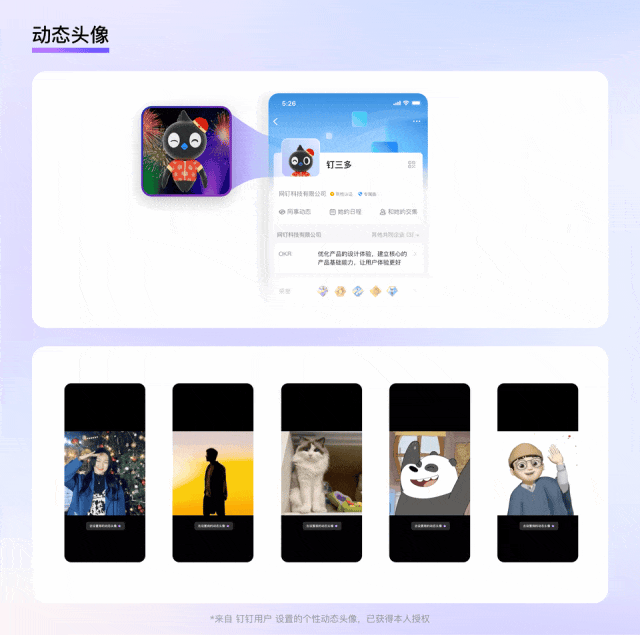
Design Practice: Personalized Profile Page Backgrounds
If avatars represent an individual's self-image, personalized profile pages serve as their "personal guide." An attractive personalized profile background captures others' attention, encouraging more proactive browsing and interaction. More than mere decoration, such backgrounds significantly enhance the user's social experience, enabling better self-expression opportunities for each user.
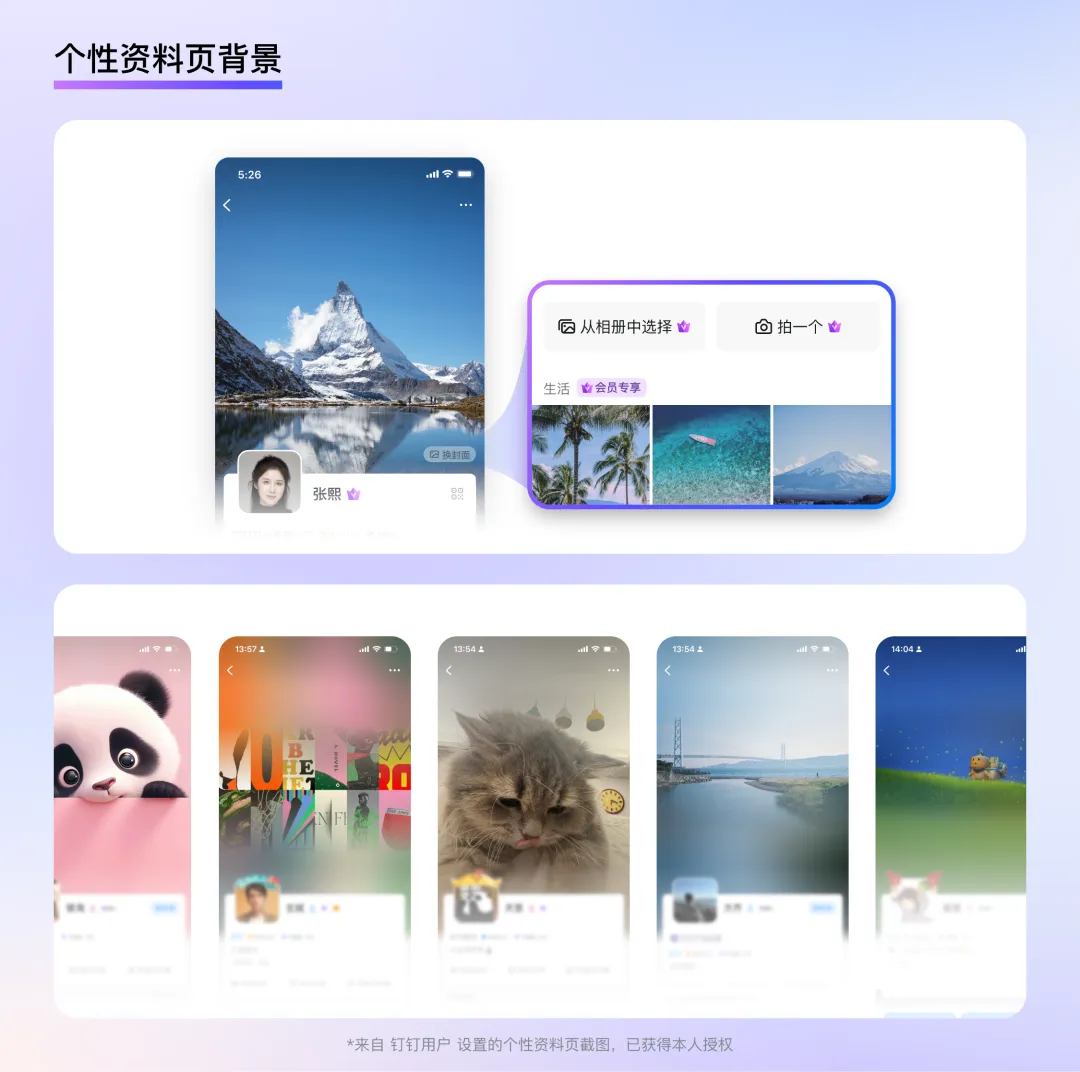
Trend 2: Personalization Meeting Individual Emotional Needs
In modern society, fast-paced lifestyles and work have become the norm. Under high-pressure working conditions, people often find themselves consumed by mundane tasks, negatively impacting quality of life and causing significant psychological fatigue. Especially within dreary and monotonous office environments, feelings of discouragement intensify.
Picture walking into the office early in the morning—cold walls, dim lighting, and employees staring lifelessly at computer screens appear to be immersed in their isolated universes. Such environments feel oppressive, making work seem like a mechanical repetition devoid of creativity and vitality. Within this atmosphere, thoughts slow down, and creativity dries up. Conversely, only by engaging with beautiful things and leveraging emotional resonance and psychological relaxation can a fertile ground for creativity emerge.
Design Practice: Launch Icons
Every company's interior design and office environment have their distinctive features, often reflecting the company’s culture and values. DingTalk's launch icon is analogous to a corporate brand front door—it's the first visual perception users encounter when starting their workday. Since its launch, DingTalk's startup icon has primarily featured a blue tone, symbolizing stability and restraint. As individuality becomes increasingly emphasized, we aim to reflect individuality, boldness, and breakthrough capabilities through this small startup icon, by redefining its material, color, and style. This subtle change also serves as motivation toward individuals, fostering a more enjoyable and comfortable work environment while inspiring frequent usage when attractive icons spark inspiration through their appealing visuals. Additionally, in the future, DingTalk plans to open up user submissions, allowing users to upload self-made icons for potential platform integration. We warmly invite everyone to participate in DIY creation!
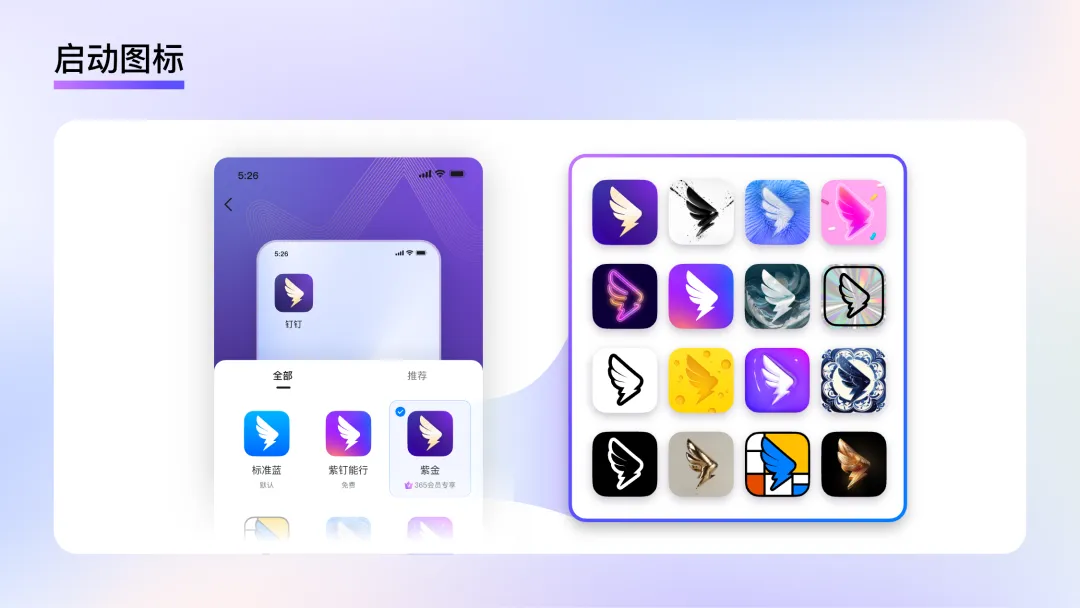
Design Practice: Custom Themes
If DingTalk's startup icon parallels a company's doorway, then DingTalk's interface themes equate to employees' office spaces. Each employee has different preferences and hobbies, resulting in varied needs regarding work environments. Some may prefer minimalist, clean office spaces, while others may prefer creatively vibrant and decorated spaces. Similar to the customizable startup icons, we provide users with a range of theme options. In an environment aligned with their preferences and style, users are more willing to invest time and energy—promoting greater creativity and productivity.
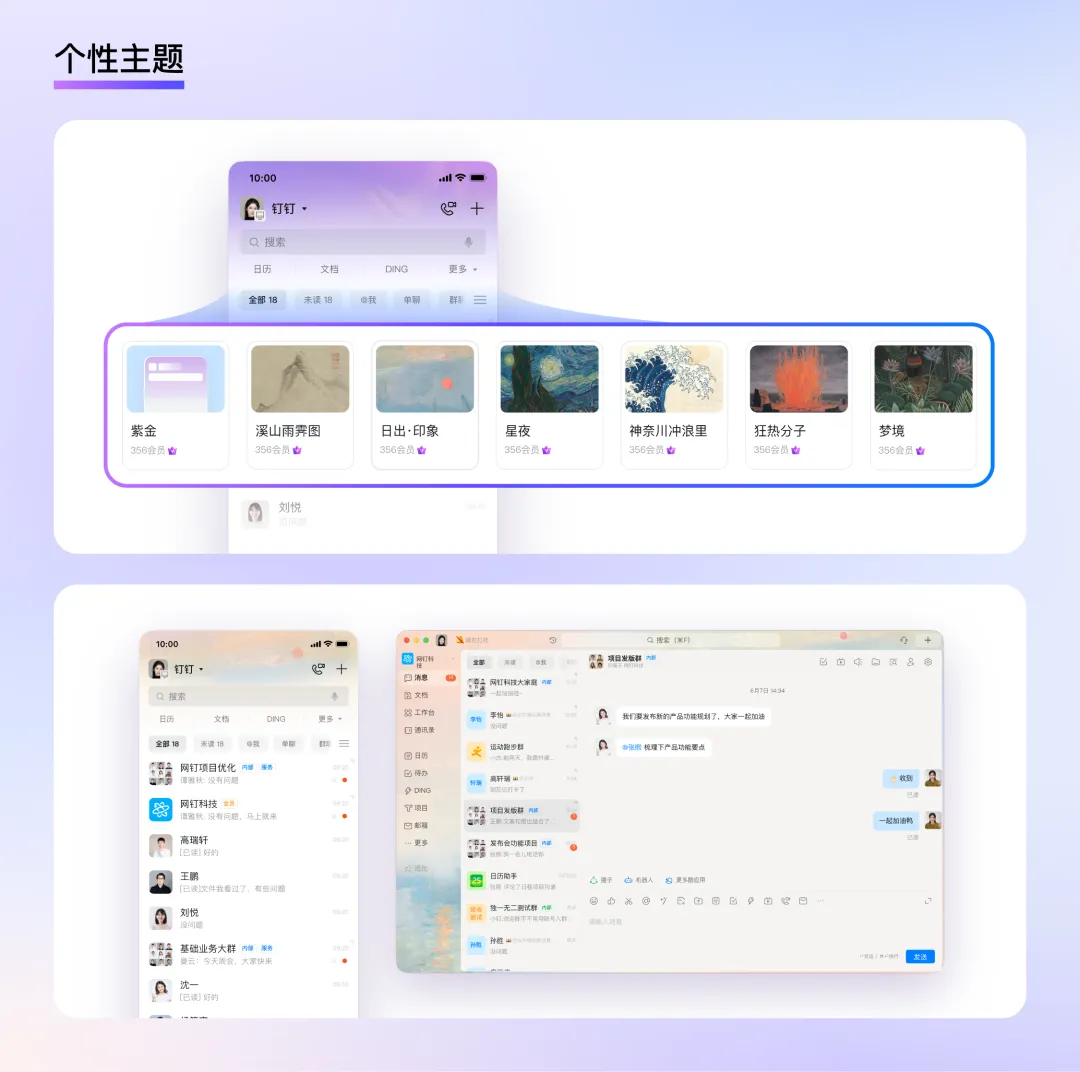
Trend 3: Highlighting Individuality to Enhance Self-Confidence
Confidence is a crucial source of both creativity and execution power. When each individual’s strengths are noticed and valued, they feel supported by the team and organization. This recognition lays the foundation for confidence, which, in turn, motivates employees to explore and innovate more boldly, to voice different opinions and suggestions, thus unleashing higher creativity in their work. Confidence also enhances personal decision-making capabilities and accountability during task execution, prompting each team member to actively seek challenges.
Design Practice: Personal Certification
In today's diverse development era, each individual possesses their unique value and potential. Everyone longs for acknowledgment. Displaying achievements and distinctive skills becomes an effective way to obtain this recognition. Hence, DingTalk aims to provide a stage where individuals can showcase themselves and share their honors, contributing not only to personal identity formation but also enhancing work-related creativity and execution through greater self-confidence. Currently, DingTalk supports vocational and academic certification; in the future, it plans to introduce support for professional skill and honor certification. Let each unique individual shine brightly and gain appreciation accordingly.
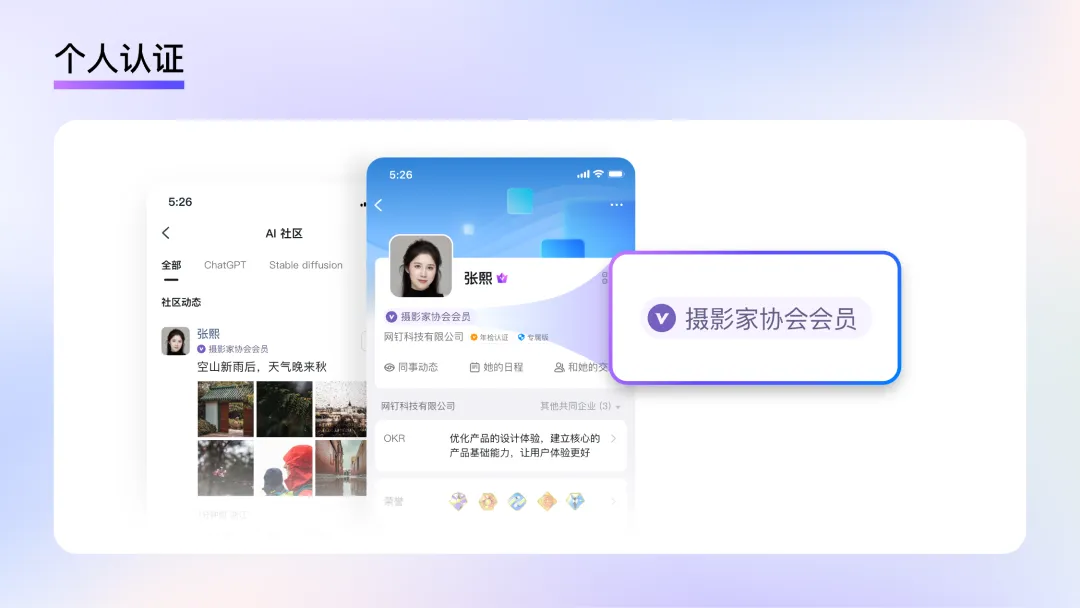
Design Practice: Personal MBTI
Collaboration is not a standardized process. When individuals of differing MBTI types (Extraversion [E] and Introversion [I], Feeling [F] and Thinking [T], Intuition [N] and Sensing [S]) collaborate, they generate different sparks of creativity. For instance, E-type colleagues favor direct interaction, while I-types may prefer written communication. F-types focus on interpersonal relationships, while T-types emphasize logical facts. N-types excel at conceptual brainstorming from a big-picture perspective, and S-types perform better on detailed execution tasks. Recognizing diverse thinking and working methodologies fosters psychological safety and acceptance within a team, encouraging everyone to express their thoughts openly.
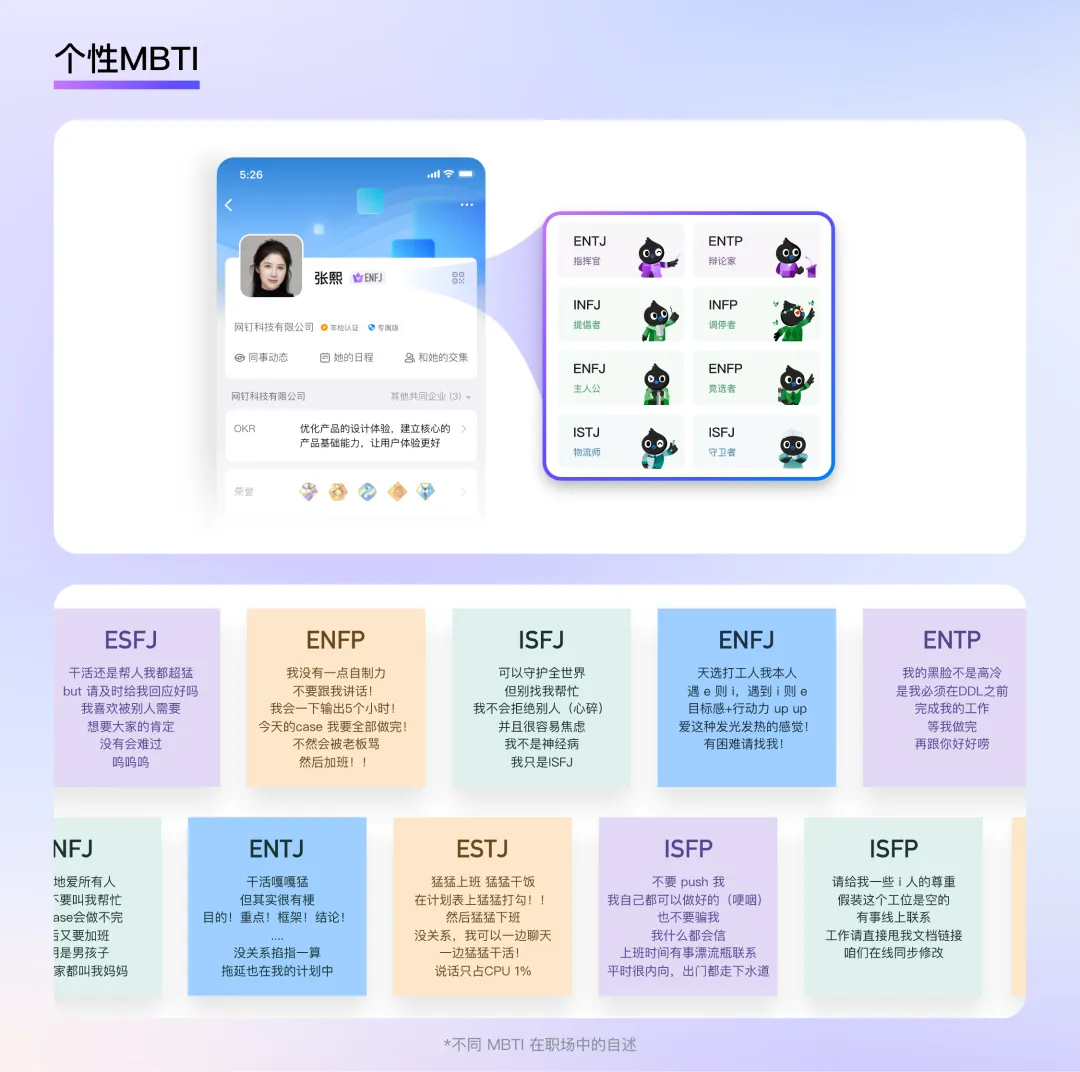
Final Words
With the rise of the Super Individual, B2B products are no longer only serving enterprises but are increasingly focused on serving individuals—a phenomenon we call "B2B C-ification." As this trend continues, future B2B design will place more emphasis on personalization to help individuals build unique identities, provide emotional value, and boost self-confidence. As a corporate communication and collaboration tool, DingTalk has consistently strived to help businesses achieve digitization. Over the past 10 years, DingTalk has grown together with its diverse clients—from large enterprises to SMEs and every Super Individual. Our focus has always revolved around meeting their unique needs and delivering distinctive experiences because we deeply understand that a company's success depends not just on product quality and service excellence but also on various aspects of the user experience.
The discussion above concludes our section on personalization trends in B2B design. Moving forward, we'll further examine the essence and development trends of B2B design by exploring style quality and layout design.
DomTech is the officially designated service partner of DingTalk in Hong Kong, specializing in catering to the needs of a wide range of clients. If you would like to learn more about the DingTalk platform and its applications, please feel free to directly consult our online customer service. Our excellent development and operations team possess rich market service experience, enabling us to offer you tailored DingTalk solutions and services.

 English
English
 اللغة العربية
اللغة العربية  Bahasa Indonesia
Bahasa Indonesia  日本語
日本語  Bahasa Melayu
Bahasa Melayu  ภาษาไทย
ภาษาไทย  Tiếng Việt
Tiếng Việt  简体中文
简体中文